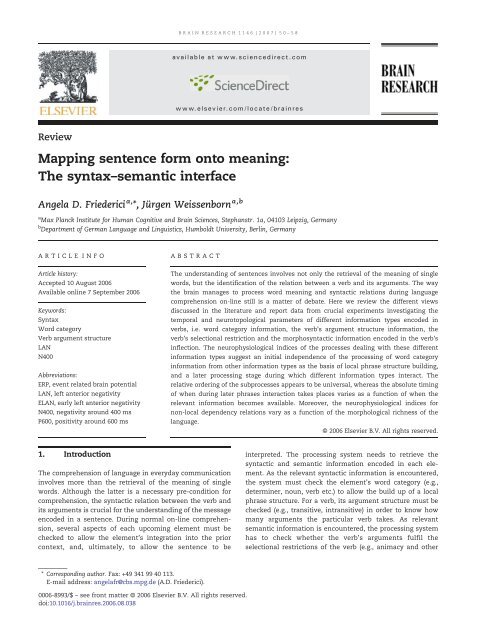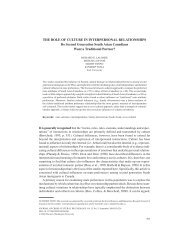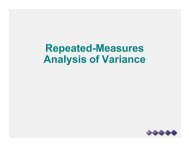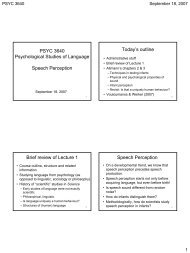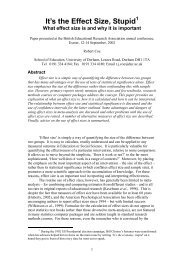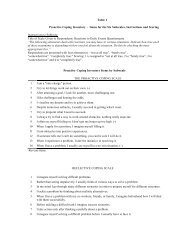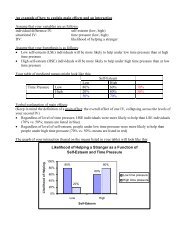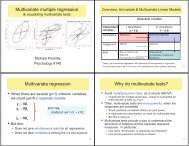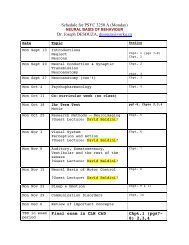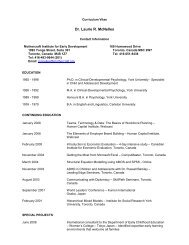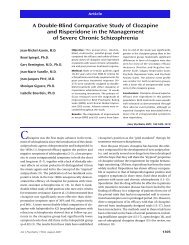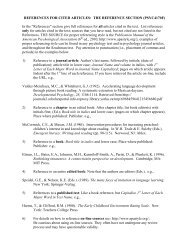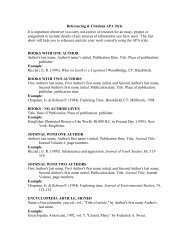Mapping sentence form onto meaning: The syntax–semantic interface
Mapping sentence form onto meaning: The syntax–semantic interface
Mapping sentence form onto meaning: The syntax–semantic interface
Create successful ePaper yourself
Turn your PDF publications into a flip-book with our unique Google optimized e-Paper software.
Review<br />
<strong>Mapping</strong> <strong>sentence</strong> <strong>form</strong> <strong>onto</strong> <strong>meaning</strong>:<br />
<strong>The</strong> <strong>syntax–semantic</strong> <strong>interface</strong><br />
Angela D. Friederici a, ⁎, Jürgen Weissenborn a,b<br />
a Max Planck Institute for Human Cognitive and Brain Sciences, Stephanstr. 1a, 04103 Leipzig, Germany<br />
b Department of German Language and Linguistics, Humboldt University, Berlin, Germany<br />
A R T I C L E I N F O A B S T R A C T<br />
Article history:<br />
Accepted 10 August 2006<br />
Available online 7 September 2006<br />
Keywords:<br />
Syntax<br />
Word category<br />
Verb argument structure<br />
LAN<br />
N400<br />
Abbreviations:<br />
ERP, event related brain potential<br />
LAN, left anterior negativity<br />
ELAN, early left anterior negativity<br />
N400, negativity around 400 ms<br />
P600, positivity around 600 ms<br />
1. Introduction<br />
<strong>The</strong> understanding of <strong>sentence</strong>s involves not only the retrieval of the <strong>meaning</strong> of single<br />
words, but the identification of the relation between a verb and its arguments. <strong>The</strong> way<br />
the brain manages to process word <strong>meaning</strong> and syntactic relations during language<br />
comprehension on-line still is a matter of debate. Here we review the different views<br />
discussed in the literature and report data from crucial experiments investigating the<br />
temporal and neurotopological parameters of different in<strong>form</strong>ation types encoded in<br />
verbs, i.e. word category in<strong>form</strong>ation, the verb’s argument structure in<strong>form</strong>ation, the<br />
verb’s selectional restriction and the morphosyntactic in<strong>form</strong>ation encoded in the verb’s<br />
inflection. <strong>The</strong> neurophysiological indices of the processes dealing with these different<br />
in<strong>form</strong>ation types suggest an initial independence of the processing of word category<br />
in<strong>form</strong>ation from other in<strong>form</strong>ation types as the basis of local phrase structure building,<br />
and a later processing stage during which different in<strong>form</strong>ation types interact. <strong>The</strong><br />
relative ordering of the subprocesses appears to be universal, whereas the absolute timing<br />
of when during later phrases interaction takes places varies as a function of when the<br />
relevant in<strong>form</strong>ation becomes available. Moreover, the neurophysiological indices for<br />
non-local dependency relations vary as a function of the morphological richness of the<br />
language.<br />
<strong>The</strong> comprehension of language in everyday communication<br />
involves more than the retrieval of the <strong>meaning</strong> of single<br />
words. Although the latter is a necessary pre-condition for<br />
comprehension, the syntactic relation between the verb and<br />
its arguments is crucial for the understanding of the message<br />
encoded in a <strong>sentence</strong>. During normal on-line comprehension,<br />
several aspects of each upcoming element must be<br />
checked to allow the element’s integration into the prior<br />
context, and, ultimately, to allow the <strong>sentence</strong> to be<br />
⁎ Corresponding author. Fax: +49 341 99 40 113.<br />
E-mail address: angelafr@cbs.mpg.de (A.D. Friederici).<br />
B R A I N R E S E A R C H 1 1 4 6 ( 2 0 0 7 ) 5 0 – 5 8<br />
ava i l a b l e a t w w w. s c i e n c e d i r e c t . c o m<br />
w w w. e l s ev i e r. c o m / l o c a t e / b r a i n r e s<br />
0006-8993/$ – see front matter © 2006 Elsevier B.V. All rights reserved.<br />
doi:10.1016/j.brainres.2006.08.038<br />
© 2006 Elsevier B.V. All rights reserved.<br />
interpreted. <strong>The</strong> processing system needs to retrieve the<br />
syntactic and semantic in<strong>form</strong>ation encoded in each element.<br />
As the relevant syntactic in<strong>form</strong>ation is encountered,<br />
the system must check the element’s word category (e.g.,<br />
determiner, noun, verb etc.) to allow the build up of a local<br />
phrase structure. For a verb, its argument structure must be<br />
checked (e.g., transitive, intransitive) in order to know how<br />
many arguments the particular verb takes. As relevant<br />
semantic in<strong>form</strong>ation is encountered, the processing system<br />
has to check whether the verb’s arguments fulfil the<br />
selectional restrictions of the verb (e.g., animacy and other
semantic features). Last but not least, the system has to<br />
process the morphosyntactic in<strong>form</strong>ation encoded in the<br />
verb’s inflection in order to identify the grammatical relation<br />
between the verb and its argument (e.g., subject–verb<br />
agreement).<br />
Different psycholinguistic theories agree that all these<br />
in<strong>form</strong>ation types must be retrieved and used to guarantee<br />
normal comprehension, but there is still some debate over<br />
the time course of these processes and the nature of the<br />
interplay between lexical–semantic and syntactic in<strong>form</strong>ation.<br />
<strong>The</strong> interactive approach holds that each in<strong>form</strong>ation<br />
type interacts with each other at every point in time<br />
(Marslen-Wilson and Tyler, 1980; MacDonald et al., 1992,<br />
1994a,b; McClelland et al., 1989; Trueswell and Tanenhaus,<br />
1994). <strong>The</strong> serial approach maintains that local phrase<br />
structure building precedes the processing of other in<strong>form</strong>ation<br />
types (DeVincenzi, 1991; Frazier, 1978, 1987a,b;<br />
Gorrell, 1995, 1998). Within the serial approach, researchers<br />
have argued that the input first undergoes a syntactic<br />
analysis before lexical–semantic in<strong>form</strong>ation is taken into<br />
account (Frazier, 1978; Frazier and Fodor, 1978). Although<br />
interaction between syntactic and lexical–semantic in<strong>form</strong>ation<br />
is assumed to take place during a later processing<br />
stage, the initial phase is modeled to take only word<br />
category in<strong>form</strong>ation into consideration for the basis of<br />
which an initial phrase structure is built. Overviews<br />
concerning the behavioral evidence for each of these<br />
views are given in Mitchell (1994); Tanenhaus and Trueswell<br />
(1995); Frazier and Clifton (1996) and in different<br />
articles published in the texts edited by Garfield (1987);<br />
Tanenhaus and Carlson (1989); Altmann (1990); Balota et al.<br />
(1990); Simpson (1991), Clifton et al., (1994); Hemforth and<br />
Konieczny (2000). Each different model is supported by<br />
empirical data from behavioral experiments, thus disallowing<br />
a final conclusion with respect to the ultimate cognitive<br />
architecture of <strong>sentence</strong> processing. Rather than reiterate<br />
the behavioral results in support of the one or the other<br />
view, the present article will discuss recent neurophysiological<br />
data against the background of a neurocognitive<br />
model of language processing (Friederici, 1995, 2002).<br />
<strong>The</strong> neurocognitive model assumes an initial phase<br />
(Phase 1) during which local phrase structure building<br />
based on word category in<strong>form</strong>ation takes places, preceding<br />
the processing of other in<strong>form</strong>ation types during on-line<br />
<strong>sentence</strong> comprehension. Thus, word category in<strong>form</strong>ation<br />
is needed to license further integration processes. In the<br />
next processing stage (Phase 2), further syntactic and<br />
semantic processes take place in parallel revealing the<br />
syntactic and the thematic relations as well as the semantic<br />
relations between words. <strong>The</strong> output of these parallel<br />
processes serves as the input to a final stage of integration<br />
(Phase 3) where the different in<strong>form</strong>ation types interact to<br />
achieve a final interpretation (Friederici, 2002, compare<br />
Table 1).<br />
<strong>The</strong> present version of the proposal assumes that the<br />
timing relation of these three processes is fixed, but that the<br />
time window for each stage can vary as a function of the<br />
particular stimulus material or language, the stimulus presentation<br />
parameters as well as the experimental paradigm<br />
and task.<br />
B R A I N R E S E A R C H 1 1 4 6 ( 2 0 0 7 ) 5 0 – 5 8<br />
Here, findings from recent event-related brain potential<br />
(ERP) studies that focused on the time course of syntactic and<br />
lexical–semantic processes in different languages and paradigms<br />
will be reviewed. We restrict our discussion to those<br />
<strong>sentence</strong> processing studies that have worked with a violation<br />
paradigm including the following different violation types:<br />
phrase structure violation, subject–verb agreement violation,<br />
verb argument violation and violation of a verb’s selectional<br />
restrictions. All of these studies center around the processing<br />
of verbs and the in<strong>form</strong>ation encoded therein. <strong>The</strong> central role<br />
of verb in<strong>form</strong>ation for language processing has been<br />
acknowledged by linguistic theory (Fillmore, 1968; Jackendoff,<br />
2002) as well as psycholinguistic modeling (Mitchell, 1994;<br />
Tanenhaus et al., 1991). We will see that seemingly equivocal<br />
neurophysiological data may ‘fall into place’ once the relation<br />
between the verb and its language-specific arguments is<br />
considered.<br />
ERP studies conducted over the past two decades have<br />
identified different ERP components which have been<br />
interpreted to relate to different functions during language<br />
comprehension. A centro-parietally distributed negativity,<br />
label N400, has been found in relation to difficulties of both<br />
semantic integration (e.g., Kutas and Hillyard, 1980; Kutas<br />
and Van Petten, 1994, Brown and Hagoort, 1993; Chwilla et<br />
al., 1995 from Hahne and Friederici, 2002) and the processing<br />
of thematic in<strong>form</strong>ation (e.g., Friederici and Frisch, 2000;<br />
Frisch and Schlesewsky, 2001; Frisch et al., 2004). Syntactic<br />
processes have been discussed with respect to left anterior<br />
negativities (ELAN/LAN) and to late centro-parietal positivities<br />
(P600) (for overviews, see Hagoort et al., 1999; Friederici,<br />
2002). More recently, P600 effects were also reported for the<br />
processing of semantic/thematic violation in <strong>sentence</strong> context<br />
(for an overview, see Kuperberg, 2007). <strong>The</strong> present<br />
discussion, however, will primarily focus on the syntaxrelated<br />
effects.<br />
A major issue in the discussion of syntax-related effects<br />
concerns the presence and absence of ELAN/LAN effects, their<br />
latency (early vs. late), as well as their topography (left<br />
Table 1<br />
Phases Violation<br />
types<br />
ERP<br />
correlates<br />
Functions<br />
Phase 1 Phrase structure ELAN Local phrase structure<br />
building<br />
Phase 2 Subject–verb<br />
agreement<br />
Verb argument LAN/N400 b<br />
Verb selectional<br />
restriction<br />
Phase 3 Possible for all<br />
types<br />
LAN a<br />
N400<br />
P600 Integration<br />
Assignment of syntactic/<br />
thematic relations and<br />
semantic relations<br />
a Presence/absence depending on the degree to which syntactic<br />
relations are assigned on the basis of inflectional morphology in a<br />
given language.<br />
b Within one language (e.g., German) depending on the violation<br />
realization, i.e. incorrect number of arguments or incorrect<br />
argument case marking and between languages depending on<br />
whether realized in a scrambling language (e.g., German) or in a<br />
fixed word order language (e.g., English).<br />
51
52 B R A I N R E S E A R C H 1 1 4 6 ( 2 0 0 7 ) 5 0 – 5 8<br />
lateralized vs. bilateral). <strong>The</strong> ultimate solution for the variance<br />
across different studies in the literature is not simple as the<br />
studies have used different violation types, languages and<br />
modalities. All these parameters may influence the appearance<br />
of the E/LAN effects. Here we will mainly consider the<br />
parameters of violation types and languages 1 .<br />
Linguistic theories would predict differences between<br />
violations of word category in<strong>form</strong>ation, relevant for the<br />
local phrase structure, and subject–verb agreement violation,<br />
relevant for the structural dependency between the NPs<br />
(arguments) and the verb in a <strong>sentence</strong>. While processes<br />
concerning violations of word category may be similar<br />
across languages, processes involved in subject–verb agreement<br />
may differ as a function of language because<br />
languages differ in how much the assignment of grammatical<br />
roles depends on morphology, i.e. person, number and<br />
case marking. We will take up these two issues and the<br />
relevant ERP data in turn.<br />
2. Computing local phrase structure<br />
<strong>The</strong> computation of a local phrase is based on word category<br />
in<strong>form</strong>ation retrieved from the word as it is available. A<br />
number of ERP studies investigating word category violations<br />
have reported an ELAN in different languages (for English, see<br />
Neville et al. (1991) for *Max’s of proof/Max’s proof; Münte et al.<br />
(1993) for *your write/you write; Kubota et al. (2004) for 7a *I<br />
believe him is a spy/I believe he is a spy).<br />
In German, ELAN effects were reported in studies investigating<br />
word category violations in <strong>sentence</strong>s containing<br />
prepositional phrases requiring a noun for their completion,<br />
but in which a verb was presented instead for example *die<br />
Pizza wurde im gegessen/the pizza was in-the eaten//die Pizza<br />
wurde gegessen/the pizza was eaten (Friederici et al., 1993; Hahne<br />
and Friederici, 1999, 2002 in EEG studies and in MEG studies<br />
Knösche et al., 1999; Friederici et al., 2000). <strong>The</strong> syntax-related<br />
negativity was present early, i.e. about 150 ms post word onset<br />
when word category in<strong>form</strong>ation was signaled by the prefix<br />
(see references above), but late with respect to word onset<br />
when word category was provided by the suffix (Friederici et<br />
al., 1996, 2004; Hagoort et al., 2003). This means that the effect<br />
was early with respect to the word category decision point.<br />
<strong>The</strong> studies seem to show an early left anterior negativity, i.e.<br />
an ELAN, when time-locked to the word category decision<br />
point.<br />
<strong>The</strong> word category decision point is also relevant in the<br />
interpretation of the results from experiments conducted by<br />
Van den Brink and Hagoort (2004). In their study, Dutch<br />
<strong>sentence</strong> material was used in which the word category verb<br />
was signaled by a suffix -de as in kliederde/messed. As the first<br />
1 Violation type and language being equal, we have argued that<br />
the ELAN component reflecting highly automatic syntactic<br />
processing of phrase structure building is more likely to be<br />
observed during the processing of connected speech than for<br />
visually presented language, especially when words are presented<br />
individually with pauses of 300 ms or more between each<br />
word or when the visual input is hampered by low visual contrast<br />
(Gunter et al., 1999).<br />
part of the crucial word klieder/mess can be read as a noun, one<br />
would predict that the word klieder -de in a noun context only<br />
elicits a left anterior negativity after the onset of the suffix -de.<br />
And this is exactly what was found.<br />
An ELAN was also found for word category violations in<br />
non-Indo-European languages, e.g., in so-called BA constructions<br />
in Chinese, which requires that the following element be<br />
a noun instead of a verb, in <strong>sentence</strong>s such as *the stylist BA cut/<br />
the stylist BA the cloth cut (Ye et al., 2006). <strong>The</strong> ELAN has also<br />
been found for word category violations in Japanese <strong>sentence</strong><br />
processing (Mueller et al., 2005).<br />
Interestingly, those studies in English and Dutch that have<br />
not found an ELAN used syntactically legal but less frequent<br />
syntactic structures and not outright violations (e.g., in Dutch,<br />
Hagoort et al., 1993). Ainsworth-Darnell et al. (1998) report an<br />
absence of an ELAN for the following <strong>sentence</strong>s: Jill entrusted<br />
the recipe to friends before.../Jill entrusted the recipe friends before, at<br />
their critical word friends. <strong>The</strong> absence of an ELAN, however, is<br />
not surprising as the word friends is a possible grammatically<br />
correct continuation in a <strong>sentence</strong>: Jill entrusted the recipe<br />
friends like most. This means that a noun after the first <strong>sentence</strong><br />
part is correct under certain conditions; therefore, no ELAN is<br />
observed.<br />
From the combined studies, we may conclude that an ELAN<br />
is observed whenever an incoming item’s word category<br />
violates the local syntactic prediction and that the latency as<br />
measured from the word onset varies, but is always early<br />
when measured from the word category decision point.<br />
<strong>The</strong> data at hand are in support of a model that predicts<br />
ELAN effects as a reflection of an initial phase of local phrase<br />
structure building. More recently, there are data suggesting<br />
that the amplitude of the ELAN may vary depending on<br />
whether ungrammaticality can be decided on the basis of the<br />
immediately preceding context alone or whether non-local<br />
preceding context has to be taken into account (Lau et al.,<br />
2006).<br />
3. Computing dependency relations<br />
3.1. Processing inflectional morphology of verbs<br />
When retrieving <strong>meaning</strong> from <strong>sentence</strong>s, the in<strong>form</strong>ation<br />
encoded in the verb inflection, in particular, the in<strong>form</strong>ation<br />
of number and person, is most relevant and in some<br />
languages it is essential for the assignment of grammatical<br />
roles (subject vs. object) in <strong>sentence</strong>s. While in languages with<br />
a fixed word order this in<strong>form</strong>ation may be unnecessary for<br />
the <strong>sentence</strong>’s interpretation, it is crucial for languages with<br />
free word order. Although Osterhout and Mobley (1995) found<br />
a LAN in a subject–verb disagreement in English, a language<br />
with a fixed word order, in simple declarative <strong>sentence</strong>s,<br />
subject–verb agreement errors (plural vs. singular) often do<br />
not elicit a LAN (Kutas and Hillyard, 1983). On the other hand,<br />
languages in which grammatical relations more heavily rely<br />
on morphosyntactic in<strong>form</strong>ation, LAN effects can be observed<br />
(Penke et al., 1997; Angrilli et al., 2002; Silva-Pereyra and<br />
Carreiras, 2006).<br />
Across different languages, a variety of morphosyntactic<br />
violation types have been investigated. Two violation types
have been examined in at least more than one language,<br />
namely subject–verb agreement and determiner–noun agreement.<br />
Those studies that focused on gender agreement<br />
between nouns and their corresponding determiner or their<br />
adjective do not always report LAN effects. It may not be<br />
surprising that gender agreement violations elicit less stable<br />
ERP effects because gender in<strong>form</strong>ation is part of the lexical<br />
entry and in some languages is phonologically constrained<br />
by the lexical <strong>form</strong> of the noun (in Spanish) while in others<br />
this is largely not the case (in French). In Spanish, LANs<br />
(Carreiras et al., 2004) or P600s (Barber et al., 2004) were<br />
observed, whereas in Dutch (Hagoort and Brown, 1999; Van<br />
Berkum et al., 2000) and in French (Foucart and Frenck-<br />
Mestre, 2004) P600s were found.<br />
For subject–verb agreement violations, stable ERP effects<br />
across different languages with strong inflectional morphology<br />
have been reported. Violations of number agreement<br />
between subject–noun and verb elicited a LAN in German<br />
(Penke et al., 1997) and in Italian (Angrilli et al., 2002;<br />
DeVincenzi et al., 2003). In another German study in which<br />
no LAN effect was found (Münte et al., 1997), the crucial<br />
<strong>sentence</strong>s did not contain outright violations but were<br />
obscured by a lexical ambiguity of the subject pronoun (sie<br />
which is ambiguous in number she/they). <strong>The</strong>refore, these<br />
findings do not challenge the argument that, in languages in<br />
which inflectional morphology (i.e. subject–verb agreement) is<br />
relevant for the assignment of grammatical roles, a LAN is<br />
observed. <strong>The</strong> latter view is corroborated by a study conducted<br />
in Hebrew, a language with noun–verb agreement in which<br />
noun gender agreement is relevant for the assignment of<br />
grammatical roles (Deutsch and Bentin, 2001). In this study, as<br />
expected based on relevance of this in<strong>form</strong>ation for grammatical<br />
role assignment, a clear LAN effect was found for gender<br />
agreement violation between the noun and the verb.<br />
Thus, LAN effects appear observable in languages in which<br />
the identification of grammatical relations depends upon the<br />
subject–verb agreement as signaled either by number, person<br />
and/or gender features. 2<br />
3.2. Processing in<strong>form</strong>ation of argument nouns<br />
<strong>The</strong> grammatical relations between a verb and its arguments<br />
in languages with free word order, such as German or<br />
Japanese, are not only marked by the verb’s inflection but<br />
moreover by the noun phrase’s inflection in the <strong>form</strong> of case<br />
marking.<br />
2 Tense agreement between the main verb and its auxiliary also<br />
seems to elicit LAN effects. This was observed for German<br />
(Friederici et al., 1993) in Dutch (Gunter et al., 1997) and in English<br />
(Osterhout and Nicol, 1999). Another study, however, in English<br />
using tense violations to test for grammatical violations (*has<br />
catch/has caught) did not find LAN (Kemmer and Kutas, 2006). In<br />
this latter study, the absence of a LAN could be due to the fact<br />
that the material used is ambiguous as the word has can be read<br />
as a main verb (e.g., he has fish in his box) and the word catch can be<br />
read as a noun. This interpretation is supported by Friederici et al.<br />
(1996) who demonstrated that an ELAN was only observed for<br />
outright violations, but not for ambiguous constructions where<br />
the crucial element could either be an auxiliary (wurde/was) or a<br />
main verb (wurde/became).<br />
B R A I N R E S E A R C H 1 1 4 6 ( 2 0 0 7 ) 5 0 – 5 8<br />
When reviewing the relevant literature, it seems that<br />
violations of the verb’s argument structure and its arguments<br />
either lead to a LAN or to an N400 depending on the language,<br />
and within a given language depending on the type of<br />
violation between the verb and its arguments in a <strong>sentence</strong>.<br />
When considering a verb’s argument structure, it is important<br />
to recognize that there are two ways it can be violated. A<br />
violation can be realized as a mismatch between the number<br />
of available arguments and those required by the verb or as a<br />
mismatch between the case marking of a given argument and<br />
that required by the verb.<br />
For German verb argument structure violations, such as<br />
Der Mann wurde geweint/<strong>The</strong> man was cried, in which an<br />
intransitive verb was presented in a passive structure requiring<br />
a transitive verb, a LAN was seen at the verb (Rösler et al.,<br />
1993). A LAN/P600 was found at the <strong>sentence</strong>’s final verb when<br />
the case of the actual object–argument (accusative) violated<br />
the verb’s argument structure (requiring a dative marked<br />
object argument), but an N400/P600 pattern was found when<br />
thematic assignment was impossible due to a mismatch<br />
between the already encountered number of arguments<br />
(three) and the number of arguments required by the verb<br />
(two) (Friederici and Frisch, 2000).<strong>The</strong>se different patterns<br />
were taken to reflect different aspects of verb argument<br />
structure. <strong>The</strong> N400/P600 pattern, in particular, was related<br />
to the fact that given the mismatch between the already<br />
perceived number of arguments (three) and the number of<br />
arguments the verb allowed (two) not only the grammatical<br />
roles, but also the thematic/semantic roles of the arguments<br />
could not be assigned. In a German study in which the two<br />
arguments of a verb carried nominative case (Frisch and<br />
Schlesewsky 2001), rendering the assignment of thematic<br />
roles impossible, an N400 followed by a P600 was also<br />
observed.<br />
In English, a language with fixed word order, case marking<br />
violations such as *<strong>The</strong> plane took we to paradise/<strong>The</strong> plane took<br />
us to paradise in which there is a mismatch between the case<br />
of the pronoun we, i.e. nominative, reserved to subjects, and<br />
its postverbal position which in a non-interrogative clause is<br />
reserved for objects, and object case, elicited a LAN (Coulson<br />
etal.,1998). Notice that in German, a free word order language,<br />
a P600 was found for a double subject structure (Frisch and<br />
Schlesewsky, 2001).<br />
A recent model by Schlesewsky and Bornkessel (2004) pays<br />
credit to these findings in that it assumes two parallel<br />
processing routes during Phase 2 of language processing: a<br />
thematic route which considers case and when marked<br />
unambiguously can map thematic roles directly and a<br />
syntactic route which is used for ambiguously marked arguments<br />
considering syntactic in<strong>form</strong>ation (e.g., word order or<br />
subject–verb agreement) instead. This latter route is generally<br />
used for languages without case marking.<br />
3.3. Processing verbs’ selectional restriction in<strong>form</strong>ation<br />
<strong>The</strong> processing of the selectional restriction violation of verbs<br />
has been studied in numerous studies across different<br />
languages. <strong>The</strong> violation of a verb’s selectional restriction<br />
elicits an N400 effect (e.g., Friederici et al., 1993). Because the<br />
N400 as a reflex of a semantic mismatch between the verb and<br />
53
54 B R A I N R E S E A R C H 1 1 4 6 ( 2 0 0 7 ) 5 0 – 5 8<br />
its arguments is well established in the literature, we will<br />
take this as a given for the further discussion (Kutas and<br />
Hillyard, 1983; Kutas and Federmeier, 2000). Most recently, it<br />
was shown that the amplitude of the N400 varies systematically<br />
as a function of the number of semantic features<br />
violating the relation between the verb and its object (Li et al.,<br />
in press).<br />
3.4. Assigning thematic and semantic relations<br />
<strong>The</strong> neurocognitive model presented in the introduction<br />
(Friederici, 2002; Friederici and Kotz, 2003) assumes that<br />
word category based processes (Phase 1) precede processes<br />
assigning semantic relations and thematic relations (Phase 2).<br />
In this model, these two latter processes are assumed to be<br />
realized in two parallel processing streams, one dealing with<br />
semantic relations, such as selectional restrictions, and one<br />
dealing with thematic role assignment on the basis of<br />
morphosyntactic in<strong>form</strong>ation, such as the verb’s inflection<br />
(subject–verb agreement) and the noun’s case (case marking of<br />
the verb’s arguments).<br />
<strong>The</strong> assumption of two parallel working processing<br />
streams during Phase 2 is based on data from experiments<br />
which varied both semantic and syntactic factors during<br />
<strong>sentence</strong> processing. Independence of the two factors was<br />
found in a study by Gunter et al. (2000), but an interaction was<br />
reported by Hagoort (2003). Thus, the data available do not<br />
unequivocally support the notion of parallel, independent<br />
processing streams during Phase 2. It appears that under<br />
certain conditions the two processing streams may interact. A<br />
crucial difference between those studies supporting interactive<br />
processes and those supporting parallel processes again<br />
may be the type of violation investigated. Hagoort (2003)<br />
examined semantic and syntactic violations within a noun<br />
phrase, i.e. between the determiner’s gender (the, neuter<br />
gender) and the noun’s gender (umbrella, common gender)<br />
on the one hand and between the adjective (honest) and the<br />
noun (umbrella) on the other, and observed an N400 effect for<br />
the pure semantic violation which was increased by the<br />
additional gender violation. This interaction effect may be due<br />
to the fact that gender in<strong>form</strong>ation is lexically based and thus<br />
not totally independent of lexical–semantic processes. Gunter<br />
et al. (2000) manipulated anomalies across phrases in German<br />
and evoked a violation that included gender and case<br />
in<strong>form</strong>ation. In doing so, they observed a LAN for the syntactic<br />
violation (*sie bereiste den Land/she travels the (masculine) Land<br />
(neuter)//sie bereiste das (neuter) Land (neuter)) and an N400 for<br />
the semantic anomaly between the noun and the prior verb<br />
(*sie befährt das Land/she drives-through the land) and found no<br />
interaction in this time window, but a LAN plus an N400 for<br />
the combined violation followed by a P600 whose amplitude<br />
varied as a function of both the syntactic and the semantic<br />
anomaly (*sie befährt den Land/she drives-through the (masculine)<br />
land (neuter)) (Gunter et al., 2000). Thus, in this study, an<br />
interaction was found for the P600, that is in Phase 3 of the<br />
neurocognitive model.<br />
For English, Kuperberg et al. (2003, 2005) also provide<br />
compelling evidence that the P600 is modulated both by<br />
syntactic and semantic in<strong>form</strong>ation. <strong>The</strong>se latter studies also<br />
varied the crucial in<strong>form</strong>ation types for elements across<br />
phrases. It is possible that the two processing streams<br />
assumed for Phase 2 work indeed in parallel, and that<br />
semantic and syntactic factors mainly interact during Phase<br />
3 when integrating syntactic and semantic representations.<br />
4. Word category in<strong>form</strong>ation meets other<br />
in<strong>form</strong>ation types<br />
<strong>The</strong> model presented in the beginning (Friederici, 1995, 2002;<br />
Friederici and Kotz, 2003) and sketched out in Table 1 makes<br />
clear predictions with respect to the independence of initial<br />
phrase structure building from processes dealing with semantic<br />
in<strong>form</strong>ation, with verb argument structure and with<br />
subject–verb agreement. In the following section, evidence<br />
for this prediction will be reviewed.<br />
4.1. Word category and semantic in<strong>form</strong>ation<br />
<strong>The</strong> most straightforward issue, given the discussion above,<br />
may be the possible interplay of word category in<strong>form</strong>ation<br />
and semantic in<strong>form</strong>ation.<br />
Studies in German revealed that combined word category<br />
and selectional restriction violations lead to an ERP pattern<br />
similar to that seen for syntactic violations only, namely an<br />
ELAN/P600 pattern (Hahne and Friederici, 2002; Friederici et<br />
al., 2004) under a grammaticality judgment task. When<br />
subjects were required to ignore the syntactic violation and<br />
to judge for semantic coherence, an early syntactic negativity<br />
and an N400 were found (Hahne and Friederici, 2002).<br />
<strong>The</strong>se results indicate that the processing of word category<br />
in<strong>form</strong>ation is independent of semantic in<strong>form</strong>ation, but<br />
that word category in<strong>form</strong>ation can influence semantic<br />
processes. It appears that, during normal on-line processing,<br />
semantic integration does not take place for words which<br />
are not syntactically licensed (have wrong word category)<br />
independent of whether the word category in<strong>form</strong>ation is<br />
available before semantic in<strong>form</strong>ation (in the word’s prefix)<br />
(Hahne and Friederici, 2002) or after the semantic in<strong>form</strong>ation<br />
(in the word’s suffix) (Friederici et al., 2004). Semantic<br />
integration can be forced by instruction, but early syntactic<br />
processes cannot be altered by instruction (Hahne and<br />
Friederici, 2002).<br />
A study in Chinese, a language with little morphosyntactic<br />
elements but with a high number of lexical elements<br />
which are ambiguous both with respect to <strong>meaning</strong> and<br />
word category, also investigated combined violations of<br />
word category and semantic relations (Ye et al., 2006). Even<br />
in Chinese, a language in which disambiguation is mainly<br />
carried out by contextual semantics, word category in<strong>form</strong>ation<br />
processes appeared prior to and independent of<br />
semantic processes. Word category in<strong>form</strong>ation, however,<br />
was found to interact with word <strong>meaning</strong> already between<br />
250 and 400 ms, which is earlier than observed in other<br />
languages. It was speculated that this early interaction may<br />
be due to the fact that Chinese has a large number of<br />
ambiguous words and semantic in<strong>form</strong>ation often is the<br />
only in<strong>form</strong>ation that allows disambiguation and that,<br />
therefore, semantic in<strong>form</strong>ation is used early during online<br />
speech comprehension. Thus, the relative timing of
processes of Phase 1 and Phase 2 appears to be universal<br />
across languages of different types, although the absolute<br />
time course can vary as a function of language type.<br />
4.2. Word category and verb argument structure<br />
<strong>The</strong> possible interplay between word category in<strong>form</strong>ation<br />
based processes and verb argument structure in<strong>form</strong>ation<br />
was investigated in the visual and auditory modality in<br />
German (Frisch et al., 2004). Word category violations (*Im<br />
Garten wurde am gearbeitet/in the garden was on-the worked) in<br />
the auditory domain elicited an ELAN/P600 and in the<br />
visual domain a P600, whereas argument structure violations<br />
(*Der Garten wurde oft gearbeitet/the garden was often<br />
worked) evoked an N400/P600 in both domains. When the<br />
two violation types were combined, no N400, but an ELAN/<br />
P600, was observed. This again provides support for the<br />
assumption that Phase 1 processes are independent of<br />
Phase 2 processes, but that Phase 2 processes can be<br />
influenced by Phase 1, such that lexical integration of an<br />
element into the context depends on being syntactically<br />
licensed.<br />
4.3. Word category and subject–verb agreement<br />
Another study in German examined the possible interplay<br />
between word category in<strong>form</strong>ation and morphosyntactic<br />
in<strong>form</strong>ation signaling subject–verb agreement (Rossi et al.,<br />
2005). <strong>The</strong> critical word in the <strong>sentence</strong> either had the<br />
incorrect word category (a verb in context obligatorily requiring<br />
a noun), an incorrect inflection (2. Person Singular) in a<br />
context obligatorily requiring another person (3. Person<br />
Singular) or both. Agreement violations elicited a LAN (450–<br />
650 ms) followed by a P600. Both the word category violation<br />
and the word category/agreement combined violation evoked<br />
an ELAN (100–200 ms) followed by a P600. <strong>The</strong> absence of the<br />
LAN effect in the combined condition can be taken as evidence<br />
for a functional primacy of phrase structure building processes<br />
based on word category in<strong>form</strong>ation (Phase 1) over<br />
agreement processes (Phase 2).<br />
<strong>The</strong>se findings support the idea that initial structure<br />
building processes of Phase 1 of the neurocognitive model<br />
are independent from the subsequent Phase 2 during which<br />
dependency relations are computed.<br />
5. Discussion<br />
<strong>The</strong> extraction of <strong>meaning</strong> from a <strong>sentence</strong> requires the<br />
assignment of grammatical relations between the verb and its<br />
arguments. When considering the underlying processes of<br />
<strong>meaning</strong> extraction on-line, we can identify a number of<br />
processing steps reflected in different ERP components.<br />
Although the data available in the literature on the processing<br />
of verb-related semantic and syntactic in<strong>form</strong>ation during<br />
<strong>sentence</strong> comprehension appear to be more complex than<br />
initially thought, a certain systematicity in the data emerges<br />
once different syntactic in<strong>form</strong>ation types and language types<br />
are taken into account.<br />
B R A I N R E S E A R C H 1 1 4 6 ( 2 0 0 7 ) 5 0 – 5 8<br />
Word category in<strong>form</strong>ation is relevant for initial phrase<br />
structure building (Phase 1). <strong>The</strong> computation of local phrase<br />
structure, such as noun phrase, verb phrase and prepositional<br />
phase, is handled by the parser prior to and independent of<br />
other in<strong>form</strong>ation types (for an exception, see Eckstein and<br />
Friederici, 2006). This process of initial phrase structure<br />
building is based on word category in<strong>form</strong>ation. As word<br />
category in<strong>form</strong>ation becomes available, the parser builds a<br />
local structure (e.g., upon encountering a preposition a<br />
prepositional phrase is opened). That is, on the basis of the<br />
subcategorization properties of the preposition which determine<br />
that only nominal lexical elements, e.g., nouns, pronouns,<br />
determiners or adjectives, but not verbal elements, e.g.,<br />
verbs or adverbs, can immediately follow the preposition, the<br />
parser can now make predictions with respect to the syntactic<br />
category of the upcoming element. <strong>The</strong> detection of a<br />
mismatch between the phrase structure-based prediction for<br />
the word category of the upcoming word and the upcoming<br />
word’s actual word category is reflected by the ELAN at the<br />
word category decision point. <strong>The</strong> ERP component is called<br />
ELAN as it is an early left anterior negativity which is early<br />
with respect to the point at which the word category<br />
in<strong>form</strong>ation becomes available (i.e. in the suffix or the word<br />
stem). <strong>The</strong> topography of this component seems to be more<br />
anterior and more left lateralized as a function of modality,<br />
with a more anterior (bilateral) distribution in the auditory<br />
domain and more left (anterior/temporal) distribution in the<br />
visual domain. Further research must determine whether the<br />
proposed parameter for the topographic variance of the ELAN<br />
holds. Dipole modeling indicates that the ELAN component is<br />
generated by four dipoles, two in the left and right inferior<br />
frontal gyri (with a stronger dipole in the left hemisphere) and<br />
two dipoles in the anterior portion of the superior temporal<br />
gyrus (with a stronger dipole in the left hemisphere) (Friederici<br />
et al., 2000). Brain imaging studies evaluating local phrase<br />
structure violations in German indicate an involvement of the<br />
anterior superior temporal gyrus and the frontal operculum in<br />
the inferior frontal gyrus as the neural network supporting<br />
local phrase structure building (Friederici et al., 2003; for a<br />
specification of this network at the level of structural<br />
connectivity, see Friederici et al., 2006).<br />
Other in<strong>form</strong>ation types relevant to computed dependencies<br />
across phrases are processed in Phase 2. <strong>The</strong>se are<br />
in<strong>form</strong>ation for the assignment of the grammatical and<br />
thematic roles such as subject–verb agreement, case of the<br />
verb’s arguments and the verb’s argument structure itself as<br />
well as semantic in<strong>form</strong>ation. <strong>The</strong> syntactic and the semantic<br />
processing streams dealing with the relation between<br />
phrases appear to be independent. This independence does<br />
not necessarily hold for within-phrase dependencies, e.g., in<br />
a noun phrase where lexically encoded gender in<strong>form</strong>ation<br />
and lexical–semantic in<strong>form</strong>ation meet. Subject–verb agreement<br />
violations are mostly found to elicit a LAN, independent<br />
of whether agreement is based on person (in German), on<br />
number (in German and Italian) or on gender in<strong>form</strong>ation (in<br />
Hebrew). As different languages use different cues to assign<br />
grammatical roles, either relying on a noun phrase’s position<br />
in the <strong>sentence</strong> (in English) or on morphosyntactic in<strong>form</strong>ation<br />
at the noun and/or the verb (in scrambling languages<br />
such as German or Japanese), it may not be surprising that<br />
55
56 B R A I N R E S E A R C H 1 1 4 6 ( 2 0 0 7 ) 5 0 – 5 8<br />
ERP findings concerning syntactic role assignment vary<br />
between different languages and/or language types.<br />
Phase 3 is conceptualized as a phase during which<br />
syntactic and lexical–semantic in<strong>form</strong>ation processed during<br />
the earlier phases is integrated. <strong>The</strong> phase is reflected in the<br />
P600 which varies not only as a function of syntactic<br />
complexity (Kaan et al., 2000) and syntactic anomaly (Osterhout<br />
and Holcomb, 1993; Friederici et al., 2002), but also as a<br />
function of semantic factors (Gunter et al., 2000). This<br />
suggests that the different in<strong>form</strong>ation types do interact<br />
during this processing stage. <strong>The</strong> left posterior superior<br />
temporal gyrus and its right homologue have been suggested<br />
as brain regions supporting these processes (Grodzinsky and<br />
Friederici, 2006). Further research, however, is needed to<br />
substantiate this suggestion.<br />
<strong>The</strong> mapping of a <strong>sentence</strong>’s <strong>form</strong> <strong>onto</strong> grammatical<br />
function, and thereby to its <strong>meaning</strong>, appears to vary from<br />
language to language depending on the degree to which the<br />
assignment of grammatical roles relies on morphology. Languages<br />
which heavily rely on morphological cues are more<br />
likely to show a LAN than languages that do not. However, the<br />
reported ELAN effects indicate that the basic process which<br />
outputs the structure of phrases <strong>onto</strong> which dependencies<br />
between phrases are built appears to be quite similar across<br />
languages—at least those investigated up to now.<br />
R E F E R E N C E S<br />
Ainsworth-Darnell, K., Shulman, H.G., Boland, J.E., 1998.<br />
Dissociating brain responses to syntactic and semantic<br />
anomalies: evidence from event-related potentials. J. Mem.<br />
Lang. 38, 112–130.<br />
Altmann, G.T.M. (Ed.), 1990. Cognitive Models of Speech<br />
Processing. MIT Press, Cambridge, MA.<br />
Angrilli, A., Penolazzi, B., Vespignani, F., De Vincenzi, M., Job, R.,<br />
Ciccarelli, L., Palomba, D., Stegagno, L., 2002. Cortical brain<br />
responses to semantic incongruity and syntactic violation in<br />
Italian language: an event-related potential study. Neurosci.<br />
Lett. 322, 5–8.<br />
Balota, D.A., Flores d’Arcais, G.B., Rayner, K. (Eds.), 1990.<br />
Comprehension Processes in Reading. Lawrence Erlbaum,<br />
Hillsdale, NJ.<br />
Barber, H., Salillas, E., Carreiras, M., 2004. Gender or genders<br />
agreement? In: Carreiras, M., Clifton, C. (Eds.), On-line Study of<br />
Sentence Comprehension; Eye-tracking, ERP and Beyond.<br />
Psychology Press, Brighton, UK, pp. 309–328.<br />
Brown, C., Hagoort, P., 1993. <strong>The</strong> processing nature of the N400:<br />
evidence from masked priming. J. Cogn. Neurosci. 5, 34–44.<br />
Carreiras, M., Salillas, E., Barber, H., 2004. Event-related potentials<br />
elicited during parsing of ambiguous relative clauses in<br />
Spanish. Brain Res. 20, 98–105.<br />
Chwilla, D.J., Brown, C., Hagoort, P., 1995. <strong>The</strong> N400 as a function of<br />
the level of processing. Psychophysiology 32, 274–285.<br />
Clifton, C., Frazier, L., Rayner, K., 1994. Perspectives on Sentence<br />
Processing. Lawrence Erlbaum Associates, Hillsdale, NJ.<br />
Coulson, S., King, J.W., Kutas, M., 1998. ERPs and domain<br />
specificity: beating a straw horse. Lang. Cogn. Proc. 13,<br />
653–672.<br />
DeVincenzi, M., 1991. Syntactic parsing strategies in Italian. <strong>The</strong><br />
Minimal Chain Principle. Studies in <strong>The</strong>oretical<br />
Psycholinguistics, vol. 12. Kluwer Academic Publishers,<br />
Dordrecht, NL.<br />
DeVincenzi, M., Job, R., Di Matteo, R., Angrilli, A., Penolazzi, B.,<br />
Ciccarelli, L., Vespignani, F., 2003. Differences in the perception<br />
and time course of syntactic and semantic violations. Brain<br />
Lang. 85, 280–296.<br />
Deutsch, A., Bentin, S., 2001. Syntactic and semantic factors in<br />
processing gender agreement in Hebrew: evidence from ERPs<br />
and eye movements. J. Mem. Lang. 45, 200–224.<br />
Eckstein, K., Friederici, A.D., 2006. It’s early: Event-related<br />
potential evidence for initial interaction of syntax and prosody<br />
in speech comprehension. J. Cogn. Neurosci. 18, 1–16.<br />
Fillmore, C.J., 1968. <strong>The</strong> case for case. In: Bach, E., Harms, R. (Eds.),<br />
Universals in Linguistic <strong>The</strong>ory. Holt, New York.<br />
Foucart, A., Frenck-Mestre, C., 2004. Processing of grammatical<br />
gender in<strong>form</strong>ation in French as first and second language.<br />
AMLaP, Aix-en-Provence, September 2004.<br />
Frazier, L., 1978. On Comprehension Sentences: Syntactic Parsing<br />
Strategies. Doctoral Dissertation, University of Connecticut.<br />
Frazier, L., 1987a. Sentence processing—A tutorial review. Atten.<br />
Per<strong>form</strong>. 12, 559–586.<br />
Frazier, L., 1987b. Syntactic processing—Evidence from Dutch. Nat.<br />
Lang. Linguist. <strong>The</strong>ory 5, 519–559.<br />
Frazier, L., Clifton, C., 1996. Construal. MIT Press, Cambridge, MA.<br />
Frazier, L., Fodor, J.D., 1978. <strong>The</strong> sausage machine—A new<br />
two-stage parsing model. Cognition 6, 291–325.<br />
Friederici, A.D., 1995. <strong>The</strong> time course of syntactic activation during<br />
language processing: a model based on neurophysiological and<br />
neurophysiological data. Brain Lang. 50, 259–281.<br />
Friederici, A.D., 2002. Towards a neural basis of auditory <strong>sentence</strong><br />
processing. Trends Cogn. Sci. 6, 78–84.<br />
Friederici, A.D., Frisch, S., 2000. Verb-argument structure<br />
processing: the role of verb-specific and argument-specific<br />
in<strong>form</strong>ation. J. Mem. Lang. 43, 476–507.<br />
Friederici, A.D., Kotz, S., 2003. <strong>The</strong> brain basis of syntactic<br />
processes: functional imaging and lesion studies. NeuroImage<br />
20, 8–17.<br />
Friederici, A.D., Pfeifer, E., Hahne, A., 1993. Event-related brain<br />
potentials during natural speech processing: effects of<br />
semantic, morphological and syntactic violations. Brain Res. 1,<br />
183–192.<br />
Friederici, A.D., Hahne, A., Mecklinger, A., 1996. <strong>The</strong> temporal<br />
structure of syntactic parsing. early and late event-related<br />
brain potential effects elicited by syntactic anomalies. J. Exp.<br />
Psychol., Learn. Mem. Cogn. 22, 1219–1248.<br />
Friederici, A.D., Wang, Y., Herrmann, C.S., Maess, B., Oertel, U.,<br />
2000. Localization of early syntactic processes in frontal and<br />
temporal cortical areas: a magnetoencephalographic study.<br />
Hum. Brain Mapp. 11, 1–11.<br />
Friederici, A.D., Hahne, A., Saddy, D., 2002. Distinct<br />
neurophysiological patterns reflecting aspects of syntactic<br />
complexity and syntactic repair. J. Psycholinguist. Res. 31,<br />
45–63.<br />
Friederici, A.D., Rüschemeyer, S.-A., Hahne, A., Fiebach, C.J., 2003.<br />
<strong>The</strong> role of left inferior frontal and superior temporal cortex in<br />
<strong>sentence</strong> comprehension: localizing syntactic and semantic<br />
processes. Cereb. Cortex 13, 170–177.<br />
Friederici, A.D., Gunter, T.C., Hahne, A., Mauth, K., 2004. <strong>The</strong><br />
relative timing of syntactic and semantic processes in <strong>sentence</strong><br />
comprehension. NeuroReport 15, 165–169.<br />
Friederici, A.D., Bahlmann, J., Heim, S., Schubotz, R.I., Anwander,<br />
A., 2006. <strong>The</strong> brain differentiates human and non-human<br />
grammars: functional localization and structural connectivity.<br />
Proc. Natl. Acad. Sci. U. S. A. 103, 2458–2463.<br />
Frisch, S., Schlesewsky, M., 2001. <strong>The</strong> N400 reflects problems of<br />
thematic hierarchizing. NeuroReport 12, 3391–3394.<br />
Frisch, S., Hahne, A., Friederici, A.D., 2004. Word category and<br />
verb-argument structure in<strong>form</strong>ation in the dynamics of<br />
parsing. Cognition 91, 191–219.<br />
Garfield, J. (Ed.), 1987. Modularity in Knowledge Representation<br />
and Natural Language Understanding. MIT Press, Cambridge,<br />
MA.
Gorrell, P., 1995. Syntax and Parsing. Cambridge Univ. Press,<br />
Cambridge, England.<br />
Gorrell, P, 1998. Syntactic analysis and reanalysis in <strong>sentence</strong><br />
processing. In: Fodor, J.D., Ferreira, F. (Eds.), Reanalysis in<br />
Sentence Processing. Kluwer Academic Publishers, Dordrecht,<br />
NL.<br />
Grodzinsky, Y., Friederici, A.D., 2006. NeuroImaging of syntax and<br />
syntactic processing. Curr. Opin. Neurobiol. 16, 240–246.<br />
Gunter, T.C., Stowe, L.A., Mulder, G., 1997. When syntax meets<br />
semantics. Psychophysiology 34, 660–676.<br />
Gunter, T.C., Friederici, A.D., Hahne, A., 1999. Brain responses<br />
during <strong>sentence</strong> reading: visual input affects central processes.<br />
NeuroReport 10, 3175–3178.<br />
Gunter, T.C., Friederici, A.D., Schriefers, H., 2000. Syntactic gender<br />
and semantic expectancy: ERPs reveal early autonomy and late<br />
interaction. J. Cogn. Neurosci. 12, 556–568.<br />
Hagoort, P., 2003. Interplay between syntax and semantics during<br />
<strong>sentence</strong> comprehension: ERP effects of combining syntactic<br />
and semantic violations. J. Cogn. Neurosci. 15, 883–899.<br />
Hagoort, P., Brown, C., 1999. Gender electrified: ERP evidence oil<br />
the syntactic nature of gender processing. J. Psycholinguist.<br />
Res. 28, 715–728.<br />
Hagoort, P., Brown, C., Groothusen, J., 1993. <strong>The</strong> syntactic positive<br />
shift (SPS) as an ERP measure of syntactic processing. Lang.<br />
Cogn. Processess 8, 439–483.<br />
Hagoort, P., Brown, C.M., Osterhout, L., 1999. <strong>The</strong> neurocognition of<br />
syntactic processing. In: Brown, C.M., Hagoort, P. (Eds.), <strong>The</strong><br />
Neurocognition of Language. Oxford Univ. Press, Oxford,<br />
pp. 273–316.<br />
Hagoort, P., Wassenaar, M., Brown, C.A., 2003. Syntax-related<br />
ERP-effects in Dutch. Brain Res. 16, 38–50.<br />
Hahne, A., Friederici, A.D., 1999. Electrophysiological evidence for<br />
two steps in syntactic analysis: early automatic and late<br />
controlled processes. J. Cogn. Neurosci. 11, 194–205.<br />
Hahne, A., Friederici, A.D., 2002. Differential task effects on<br />
semantic and syntactic processes as revealed by ERPs. Brain<br />
Res. 13, 339–356.<br />
Hemforth, B., Konjeczny, L. (Eds.), 2000. German Sentence<br />
Processing. Kluwer Academic Publishers, Dordrecht.<br />
Jackendoff, R., 2002. <strong>The</strong> mind doesn’t work that way: the scope<br />
and limits of computational psychology. Language 78, 164–170.<br />
Kaan, E., Harris, A., Gibson, E., Holcomb, P., 2000. <strong>The</strong> P600 as an<br />
index of syntactic integration difficulty. Lang. Cogn. Proc. 15,<br />
159–201.<br />
Kemmer, L., Kutas, M., 2006. Salience of grammatical violations,<br />
but not verb (ir)regularity, affects the P600: an event-related<br />
brain potential study. J. Cong. Neurosci. 125.<br />
Knösche, T., Maess, B., Friederici, A.D., 1999. Processing of<br />
syntactic in<strong>form</strong>ation monitored by brain surface current<br />
density mapping based on MEG. Brain Topogr. 12, 75–87.<br />
Kubota, M., Ferrari, P., Robert, T.P.L., 2004. Human neuronal<br />
encoding of English syntactic violations as revealed by both L1<br />
and L2 speakers. Neurosci. Lett. 368, 235–240.<br />
Kuperberg, G.R., 2007. Neural mechanisms of language<br />
comprehension: Challenges to syntax. Brain Res. 1146, 23–49.<br />
Kuperberg, G.R., Sitnikova, T., Caplan, D., Holcomb, P.J., 2003.<br />
Electrophysiological distinctions in processing conceptual<br />
relationships within simple <strong>sentence</strong>s. Brain Res. 17,<br />
117–129.<br />
Kuperberg, G.R., Kreher, D., Blais, K., Caplan, D., Holcomb, P., 2005.<br />
Semantic influences on syntactic processing: evidence from<br />
event-related potentials. J. Cogn. Neurosci. 29.<br />
Kutas, M., Federmeier, K.D., 2000. Electrophysiology reveals<br />
semantic memory use in language comprehension. Trends<br />
Cogn. Sci. 4, 463–470.<br />
Kutas, M., Hillyard, S.A., 1980. Reading senseless <strong>sentence</strong>s:<br />
brain potentials reflect semantic incongruity. Science 207,<br />
203–205.<br />
Kutas, M., Hillyard, S.A., 1983. Event-related brain potentials to<br />
B R A I N R E S E A R C H 1 1 4 6 ( 2 0 0 7 ) 5 0 – 5 8<br />
grammatical errors and semantic anomalies. Mem. Cogn. 11,<br />
539–550.<br />
Kutas, M., Van Petten, C., 1994. Psycholinguistics electrified.<br />
Event-related brain potential investigations. In: Gernsbacher,<br />
M.A. (Ed.), Handbook of Psycholinguistics. Academic Press, San<br />
Diego, pp. 83–143.<br />
Lau, E., Stroud, C., Plesch, S., Philips, C., 2006. <strong>The</strong> role of structural<br />
prediction in rapid syntactic analysis. Brain Lang. 98, 74–88.<br />
Li, X., Shu, H., Liu, Y.Y., Li, P., in press. Mental representation of<br />
verb <strong>meaning</strong>s: behavioral and electrophysiological evidence.<br />
J. Cogn. Neurosci.<br />
MacDonald, M.C., Just, M.A., Carpenter, P.A., 1992. Working<br />
memory constraints on the processing of syntactic ambiguity.<br />
Cognit. Psychol. 24, 56–98.<br />
MacDonald, M.C., Pearlmutter, N.J., Seidenberg, M.S., 1994a.<br />
Lexical nature of syntactic ambiguity resolution. Psychol. Rev.<br />
101, 676–703.<br />
MacDonald, M.C., Pearlmutter, N.J., Seidenberg, M.S., 1994b.<br />
Syntactic ambiguity resolution as lexical ambiguity resolution.<br />
In: Clifton Jr., C., Frazier, L., Rayner, K. (Ed.), Perspectives on<br />
Sentence Processing. Lawrence Erlbaum, Hillsdale,<br />
NJ, pp. 123–154.<br />
Marslen-Wilson, W.D., Tyler, L.K., 1980. <strong>The</strong> temporal structure of<br />
spoken language understanding. Cognition 8, 1–71.<br />
McClelland, R.J., St.John, M., Taraban, R., 1989. An interaction<br />
model of context effects in letter perception: Part 1. An account<br />
of basic findings. Lang. Cogn. Processes 4, 287–336.<br />
Mitchell, D.C., 1994. Sentence parsing. In: Gernsbacher, M.A. (Ed.),<br />
Handbook of Psycholinguistics. Academic Press, San Diego,<br />
pp. 375–409.<br />
Mueller, J.L., Hahne, A., Fujii, Y., Friederici, A.D., 2005. Native and<br />
nonnative speakers’ processing of a miniature version of<br />
Japanese as revealed by ERPs. J. Cogn. Neurosci. 17,<br />
1229–1244.<br />
Münte, T.F., Heinze, H.J., Mangun, G.R., 1993. Dissociation of brain<br />
activity related to syntactic and semantic aspects of language.<br />
J. Cogn. Neurosci. 5, 335–344.<br />
Münte, T.F., Szentkuti, A., Wieringa, B.M., Matzke, M., Johannes, S.,<br />
1997. Human brain potentials to reading syntactic errors in<br />
<strong>sentence</strong>s of different complexity. Neurosci. Lett. 235,<br />
105–108.<br />
Neville, H., Nicol, J.L., Barss, A., Forster, K.I., Garrett, M.F., 1991.<br />
Syntactically based <strong>sentence</strong> processing classes—Evidence<br />
from event-related brain potentials. J. Cogn. Neurosci. 3,<br />
151–165.<br />
Osterhout, L., Holcomb, P.J., 1993. Event-related potentials and<br />
syntactic anomaly—Evidence of anomaly detection during<br />
the perception of continuous speech. Lang. Cogn. Proc. 8,<br />
413–437.<br />
Osterhout, L., Mobley, L.A., 1995. Event-related brain potentials<br />
elicited by failure to agree. J. Mem. Lang. 34, 739–773.<br />
Osterhout, L., Nicol, J., 1999. On the distinctiveness, independence,<br />
and time course of the brain responses to syntactic and<br />
semantic anomalies. Lang. Cogn. Proc. 14, 283–317.<br />
Penke, M., Weyerts, H., Gross, M., Zander, E., Münte, T.F., Clahsen,<br />
H., 1997. How the brain processes complex words: an<br />
event-related potential study of German verb inflections. Brain<br />
Res. 6, 37–52.<br />
Rossi, S., Gugler, M.F., Hahne, A., Friederici, A.D., 2005. When word<br />
category in<strong>form</strong>ation encounters morphosyntax: an ERP study.<br />
Neurosci. Lett. 384, 228–233.<br />
Rösler, F., Pütz, P., Friederici, A.D., Hahne, A., 1993. Event-related<br />
brain potentials while encountering semantic and syntactic<br />
constraint violations. J. Cogn. Neurosci. 5, 345–362.<br />
Schlesewsky, M., Bornkessel, I., 2004. On incremental<br />
interpretation: degrees of <strong>meaning</strong> accessed during <strong>sentence</strong><br />
comprehension. Lingua 114, 1213–1234.<br />
Silva-Pereyra, J., Carreiras, M., 2006. An ERP study of PHI-features<br />
in Spanish. J. Cogn. Neurosci. 130.<br />
57
58 B R A I N R E S E A R C H 1 1 4 6 ( 2 0 0 7 ) 5 0 – 5 8<br />
Simpson, J., 1991. Understanding Word and Sentence<br />
North-Holland, Amsterdam, NL.<br />
Tanenhaus, M.K., Carlson, G.N., 1989. Lexical structure and<br />
language comprehension. In: Marslen-Wilson, W. (Ed.), Lexical<br />
Representation and Process. MIT Press, Cambridge MA.<br />
Tanenhaus, M.K., Trueswell, J.C., 1995. Sentence comprehension.<br />
In: Miller, J.L., Eimas, P.D. (Eds.), Speech Language and<br />
Communication. . Handbook in Perception and Cognition,<br />
vol. 11. Academic Press, San Diego, CA, pp. 217–262.<br />
Tanenhaus, M.K., Trueswell, J.C., Juliano, C., 1991. Verb-based<br />
lexical in<strong>form</strong>ation and parsing. Bull. Psychon. Soc. 29, 481.<br />
Trueswell, J.C., Tanenhaus, M.K., 1994. Toward a lexicalist<br />
framework of constraint-based syntactic ambiguity<br />
resolution. In: Clifton, C., Jr., L., Frazier, K. (Eds.), Perspectives<br />
on Sentence Processing. Lawrence Erlbaum, Hillsdale, NJ,<br />
pp. 155–180.<br />
Van Berkum, J.J.A., Hagoort, P., Brown, C.M., 2000. <strong>The</strong> use of<br />
referential context and grammatical gender in parsing: a reply<br />
to Brysbaert and Mitchell. J. Psychol. Res. 29, 467–481.<br />
Van den Brink, D., Hagoort, P., 2004. <strong>The</strong> influence of semantic and<br />
syntactic context constraints on lexical selection and<br />
integration in spoken-word comprehension as revealed by<br />
ERPs. J. Cogn. Neurosci. 16, 1068–1084.<br />
Ye, Z., Luo, Y., Friederici, A.D., Zhou, X., 2006. Semantic and<br />
syntactic processing in Chinese <strong>sentence</strong> comprehension:<br />
evidence from event-related potentials. Brain Res. 1071, 186–196.


